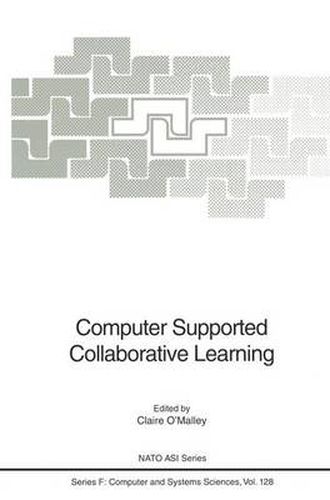Readings Newsletter
Become a Readings Member to make your shopping experience even easier.
Sign in or sign up for free!
You’re not far away from qualifying for FREE standard shipping within Australia
You’ve qualified for FREE standard shipping within Australia
The cart is loading…






This title is printed to order. This book may have been self-published. If so, we cannot guarantee the quality of the content. In the main most books will have gone through the editing process however some may not. We therefore suggest that you be aware of this before ordering this book. If in doubt check either the author or publisher’s details as we are unable to accept any returns unless they are faulty. Please contact us if you have any questions.
Although research in collaborative learning has a fairly long history, dating back at least to the early work of Piaget and Vygotsky, it is only recently that workers have begun to apply some of its findings to the design of computer based learning systems. The early generation of the!le systems focused on their potential for supporting individual learning: learning could be self paced; teaching could be adapted to individual learners’ needs. This was certainly the promise of the later generation of intelligent tutoring systems. However, this promise has yet to be realised. Not only are there still some very difficult research problems to solve in providing adaptive learning systems, but there are also some very real practical constraints on the widespread take up of individualised computer based instruction. Reseachers soon began to realise that the organisational, cultural and social contexts of the classroom have to be taken into account in designing systems to promote effective learning. Much of the work that goes on in classrooms is collaborative, whether by design or not. Teachers also need to be able to adapt the technology to their varying needs. Developments in technology, such as networking, have also contributed to changes in the way in which computers may be envisaged to support learning. In September 1989, a group of researchers met in Maratea, Italy, for a NATO-sponsored workshop on Computer supported collaborative . learning . A total of 20 researchers from Europe (Belgium.
$9.00 standard shipping within Australia
FREE standard shipping within Australia for orders over $100.00
Express & International shipping calculated at checkout
Stock availability can be subject to change without notice. We recommend calling the shop or contacting our online team to check availability of low stock items. Please see our Shopping Online page for more details.
This title is printed to order. This book may have been self-published. If so, we cannot guarantee the quality of the content. In the main most books will have gone through the editing process however some may not. We therefore suggest that you be aware of this before ordering this book. If in doubt check either the author or publisher’s details as we are unable to accept any returns unless they are faulty. Please contact us if you have any questions.
Although research in collaborative learning has a fairly long history, dating back at least to the early work of Piaget and Vygotsky, it is only recently that workers have begun to apply some of its findings to the design of computer based learning systems. The early generation of the!le systems focused on their potential for supporting individual learning: learning could be self paced; teaching could be adapted to individual learners’ needs. This was certainly the promise of the later generation of intelligent tutoring systems. However, this promise has yet to be realised. Not only are there still some very difficult research problems to solve in providing adaptive learning systems, but there are also some very real practical constraints on the widespread take up of individualised computer based instruction. Reseachers soon began to realise that the organisational, cultural and social contexts of the classroom have to be taken into account in designing systems to promote effective learning. Much of the work that goes on in classrooms is collaborative, whether by design or not. Teachers also need to be able to adapt the technology to their varying needs. Developments in technology, such as networking, have also contributed to changes in the way in which computers may be envisaged to support learning. In September 1989, a group of researchers met in Maratea, Italy, for a NATO-sponsored workshop on Computer supported collaborative . learning . A total of 20 researchers from Europe (Belgium.